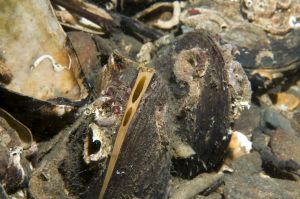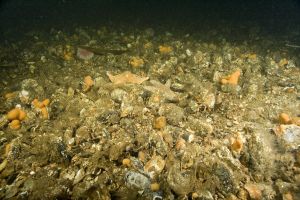No edit summary |
No edit summary |
||
| (One intermediate revision by the same user not shown) | |||
| Line 1: | Line 1: | ||
[[File:HorseMussel.jpg|alt=Date: 24/08/2011 Annat Narrows, Lochs Eil and Linnhe Graham Saunders © Marine Scotland. All rights reserved. Please email for details - marinephotos@nature.scot|thumb|Modiolus bed: Modiolus modiolus and Spirobranchus sp. © Marine Scotland. All rights reserved ]] | [[File:HorseMussel.jpg|alt=Date: 24/08/2011 Annat Narrows, Lochs Eil and Linnhe Graham Saunders © Marine Scotland. All rights reserved. Please email for details - marinephotos@nature.scot|thumb|Modiolus bed: Modiolus modiolus and Spirobranchus sp. © Marine Scotland. All rights reserved ]] | ||
Modiolus modiolus, is commonly known as horse mussel | Modiolus modiolus, is commonly known as horse mussel. When this species covers 30% or more of the seabed with a stabilising effect, they can form the Modiolus modiolus beds or reefs (OSPAR Comission, 2009; NatureScot, 2017). | ||
Usually, horse mussels are part-buried in soft to coarse sediment or attached to rocks, often in tide-swept areas. The horse mussels have a wide distribution, but the horse mussel beds are more limited in their distribution (OSPAR Comission, 2009). | |||
The main threat to M.modiolus beds | The main threat to M.modiolus beds is fishing activities with trawls and dredges, damaging both the Modiolus and associated epibenthic species (OSPAR Comission, 2008). In addition, aggregate extraction, trenching and pipe/cable-laying, dumping of spoil/cuttings or use of jack-up drilling rigs are also likely to damage horse mussel beds (OSPAR Comission, 2008).[[File:HorseMusselBed.jpg|thumb|A horse mussel bed with dead mans finger and common starfish. © Marine Scotland. All rights reserved]] | ||
[[File:HorseMusselBed.jpg|thumb|A horse mussel bed with dead mans finger and common starfish. © Marine Scotland. All rights reserved]] | |||
'''Sources:''' | '''Sources:''' | ||
| Line 14: | Line 13: | ||
NatureScot. Scotland's Nature Agency (2017). "Horse mussel beds". [https://www.nature.scot/landscapes-and-habitats/habitat-types/coast-and-seas/marine-habitats/horse-mussel-beds Retrieved from https://www.nature.scot/landscapes-and-habitats/habitat-types/coast-and-seas/marine-habitats/horse-mussel-beds] on 2022-02-15. | NatureScot. Scotland's Nature Agency (2017). "Horse mussel beds". [https://www.nature.scot/landscapes-and-habitats/habitat-types/coast-and-seas/marine-habitats/horse-mussel-beds Retrieved from https://www.nature.scot/landscapes-and-habitats/habitat-types/coast-and-seas/marine-habitats/horse-mussel-beds] on 2022-02-15. | ||
'''A big thank you for Marine Scotland for letting us use some of their | '''A big thank you for Marine Scotland for letting us use some of their photos in our page, namely:''' | ||
* "A Modiolus modiolus bed with Alcyonium digitatum, Asterias rubens, hydroids and Paguridae sp." Date: 22/08/2011. Loch Linnhe Graham Saunders © Marine Scotland. All rights reserved. Please email for details - marinephotos@nature.scot. | * "A Modiolus modiolus bed with Alcyonium digitatum, Asterias rubens, hydroids and Paguridae sp." Date: 22/08/2011. Loch Linnhe Graham Saunders © Marine Scotland. All rights reserved. Please email for details - marinephotos@nature.scot. | ||
Latest revision as of 11:34, 15 March 2022
Modiolus modiolus, is commonly known as horse mussel. When this species covers 30% or more of the seabed with a stabilising effect, they can form the Modiolus modiolus beds or reefs (OSPAR Comission, 2009; NatureScot, 2017).
Usually, horse mussels are part-buried in soft to coarse sediment or attached to rocks, often in tide-swept areas. The horse mussels have a wide distribution, but the horse mussel beds are more limited in their distribution (OSPAR Comission, 2009).
The main threat to M.modiolus beds is fishing activities with trawls and dredges, damaging both the Modiolus and associated epibenthic species (OSPAR Comission, 2008). In addition, aggregate extraction, trenching and pipe/cable-laying, dumping of spoil/cuttings or use of jack-up drilling rigs are also likely to damage horse mussel beds (OSPAR Comission, 2008).
Sources:
OSPAR Commission (2008). "Case Reports for the OSPAR List of Threatened and/or Declining Species and Habitats". Retrieved from https://www.ospar.org/site/assets/files/44271/horse_mussel_beds.pdf, on 2022-02-10.
OSPAR Commission (2009). "Background Document for Modiolus modiolus beds". Retrieved from https://www.ospar.org/documents?v=7193, on 2022-02-10.
NatureScot. Scotland's Nature Agency (2017). "Horse mussel beds". Retrieved from https://www.nature.scot/landscapes-and-habitats/habitat-types/coast-and-seas/marine-habitats/horse-mussel-beds on 2022-02-15.
A big thank you for Marine Scotland for letting us use some of their photos in our page, namely:
- "A Modiolus modiolus bed with Alcyonium digitatum, Asterias rubens, hydroids and Paguridae sp." Date: 22/08/2011. Loch Linnhe Graham Saunders © Marine Scotland. All rights reserved. Please email for details - marinephotos@nature.scot.
- "Modiolus bed: Modiolus modiolus and Spirobranchus sp." Date: 24/08/2011. Annat Narrows, Lochs Eil and Linnhe Graham Saunders © Marine Scotland. All rights reserved. Please email for details - marinephotos@nature.scot. Image ref: SNH_LL_2011_IMG_4139a.tif


 Co-funded by the European Union.
Co-funded by the European Union.